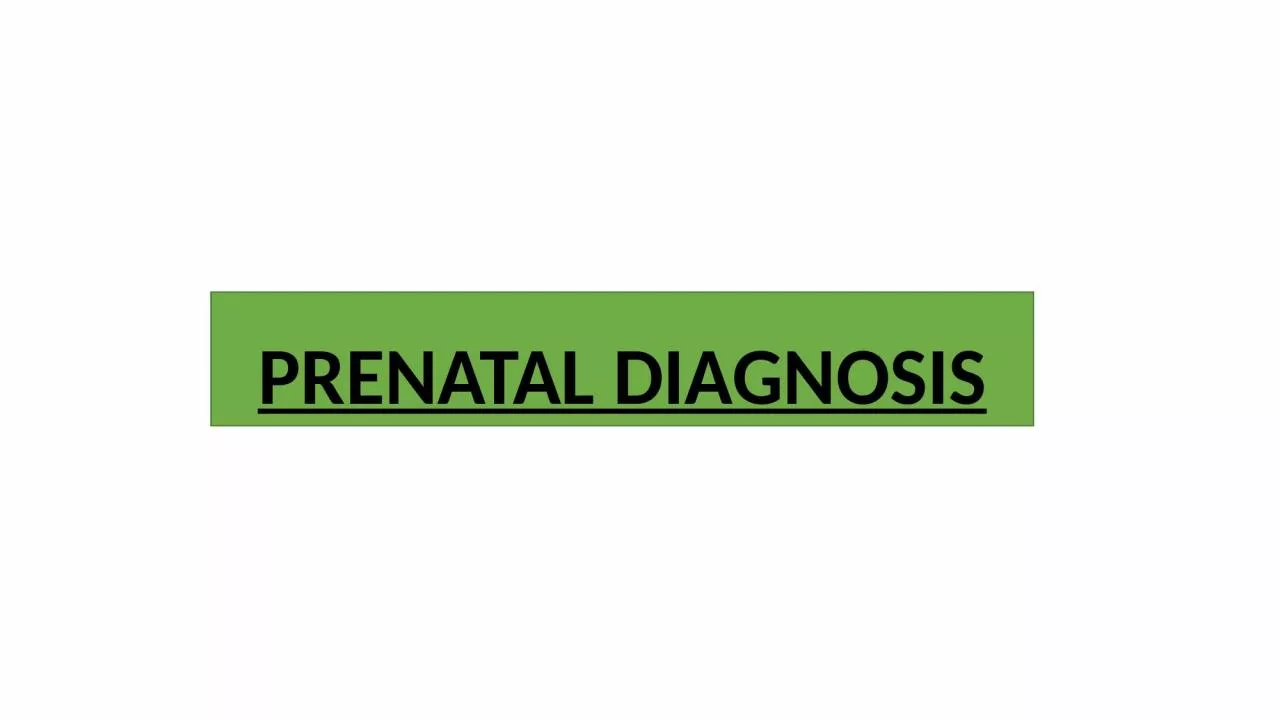

Many techniques are available to assess the growth and developmental status of the fetus including Ultrasound Maternal serum screening Amniocentesis Chorionic villus sampling ID: 930673
Download Presentation The PPT/PDF document "PRENATAL DIAGNOSIS Prenatal diagnosis" is the property of its rightful owner. Permission is granted to download and print the materials on this web site for personal, non-commercial use only, and to display it on your personal computer provided you do not modify the materials and that you retain all copyright notices contained in the materials. By downloading content from our website, you accept the terms of this agreement.
Slide1
PRENATAL DIAGNOSIS
Slide2Prenatal diagnosis
Many techniques are available to assess
the
growth and
developmental status
of the
fetus, including
Ultrasound
Maternal
serum
screening
Amniocentesis
Chorionic
villus
sampling
(CVS)
Slide3Ultrasonogrphy
Is a relatively noninvasive technique that uses high frequency sound waves reflected from tissues to create images. This approach may be
trans
abdominal
or
transvaginal
.
Transvaginal
ultrasound producing images with high resolution.
Important parameters
revealed by ultrasound include
Fetal age and growth
Presence or absence of congenital anomalies
Amount of amniotic fluid
Placental position and umbilical blood flow
Number of gestation
Slide4Fetal age and growth are assessed by
crown –rump length during the 5
th
to the 10
th
weeks of gestation .After that , a combination of measurements-including the
biparietal
diameter (BPD)
of the skull,
femur length
,
and
abdominal
circumference
are used.
Multiple
measurements of
these
parameters over time
improve the
ability to
determine
the extent of fetal growth
.
Congenital
malformations
that can be
determined
by
ultrasound are;
Neural
tube
defects,
anencephaly and
spina
bifida
A
bdominal
wall defects, such as omphalocele
Heart
and facial defects, including cleft lip and
palate.
Slide5Ultrasound can also be used to screen for
Down
syndrome
and
some
other
chromosome-related
abnormalities through a test called
nuchal translucency
.
This
test involves measurement of
the
translucent space at the
posterior
of the
baby’s
neck, where fluid
accumulates when Down
syndrome
and
some other abnormalities are present
.
The
test is performed at 11 to 14 weeks
of
pregnancy.
Information
from this test,
combined
with maternal
serum screening
test results and the mother’s
age.
Slide6Maternal Serum Screening
One
of the
first
of these tests assessed
serum
a
-fetoprotein
(
AFP
)
concentrations.
AFP
is
produced normally
by the fetal liver, peaks
at approximately 14
weeks, and “leaks” into the
maternal
circulation via the placenta.
Thus
, AFP
concentrations increase
in maternal serum during
the second
trimester and then begin a steady decline
after
30 weeks
of gestation.
In
cases of neural tube
defects,
omphalocele,
bladder
exstrophy
,
and other congenital malformations,
AFP levels increase in amniotic fluid and maternal serum.
Slide7In other instances, AFP
concentrations
decrease, as, for example
,
in Down syndrome
,
trisomy 18, sex chromosome abnormalities
,
and
triploidy
.
AFP
screening, combined with
testing
other second trimester markers
(
e.g.,
human
chorionic
gonadotropin
(HCG), unconjugated
estriol
,
and
inhibin
A
)
can increase the detection rate
for birth
defects using these serum screening studies.
Slide8Amniocentesis
During
amniocentesis, a needle is inserted
trans abdominally into
the amniotic cavity (
identified by ultrasound)
and approximately
20
to
30 mL
of
fluid
is withdrawn. Because of
the amount of fluid
required, the procedure is not
usually
performed
before 14 weeks’
gestation.
The fluid itself is analyzed for biochemical
factors , such as
AFP
and
acetylcholinesterase. In addition, fetal cells, sloughed into
the amniotic
fluid
,
can be recovered and used for metaphase
karyotyping and
other genetic
analyses.
Slide9Chorionic Villus
Sampling(CVS)
CVS
involves inserting a needle
transabdominally
or
transvaginally
into the placental
mass and aspirating approximately 5 to 30 mg of villus tissue.
Because
of
the large
number of cells obtained, only 2 to 3 days
in culture are necessary
to permit genetic analysis.
Slide10The risk of procedure-related pregnancy loss from CVS when performed by experienced
individuals appears to
approach that of amniocentesis.
Previously,
invasive procedures
,
such as
aminocentesis
and CVS
, were
offered
only to women at higher risk.
In recent years, risks associated with these procedures have decreased and, consequently, these procedures have been made more widely available.
Slide11Factors that place women at high
risk
include the following:
●
Advanced maternal age (35 years and older
);
●
Previous family history of
a genetic
problem
,
such as the parents
having
had a child
with Down
syndrome or a neural tube defect
;
●
The presence of maternal disease, such
as
diabetes;
●
An
abnormal ultrasound or serum screening test.
Slide12Fetal therapy
Modern
medicine has also made the fetus a patient who can receive
treatment, such as;
Fetal Transfusion
In cases of fetal anemia
, or
other causes produced by maternal
antibodies ,blood transfusions
for the fetus can be performed.
Fetal Medical Treatment
Fetal Surgery
Stem Cell Transplantation and
GeneTherapy
Slide13THANK YOU